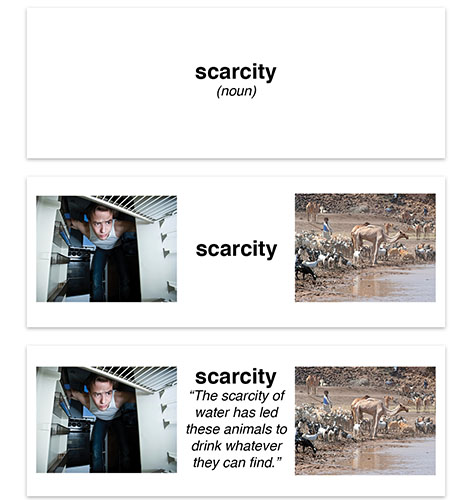What?
When?
Before reading
Why?
How?
Choose vocabulary words from the central text. Select a subset of words that no or few students know.
Round 1: Display the unknown word and its part of speech. Have students speculate about its meaning. Ask if they’ve ever heard or seen the word. Search for and dissect its parts. Ask if the word is part of a word family. Students can predict the definition aloud or respond on a worksheet (see variations).
Round 2: Display the same word, this time accompanied by an image or object that illustrates the word’s meaning as used in the central text. This will help students distinguish between possible meanings. Students revise their prediction.
Round 3: Display the word and image, this time accompanied by a sentence (not from the text). Again, if the word has multiple meanings, craft a sentence that references the meaning most relevant to the central text. Students revise their prediction again. Teachers may skip round 4 and go to round 5.
Round 4: Move to the central text where students will encounter the vocabulary word in an authentic context. Have students highlight the words surrounding the vocabulary word and infer meaning from context clues. Students reflect on their previous responses and submit their final predictions.
Round 5: Share either a dictionary or student-friendly definition. Allow time for students to reflect on the accuracy of their predictions throughout the rounds.
Complete vocabulary rounds routinely through the year to help students master this strategy and develop independent word-learning habits.
English language learners
Have students keep a log or journal of their new vocabulary.
Connection to anti-bias education
Vocabulary rounds build critical thinking and integrate multiple perspectives into word study. Students acquire language and become more diversity-minded.
Sample rounds:

Variation A: At the end of each round, students choose their best guess from a list of definitions provided by the teacher.
- A small and inadequate amount; a shortage
- A type of city where people are constantly scaring each other.
- Something used to scare away small animals in the beginning stages of crop growth.
- A rare skin disease where small scars are left on the skin after scabbing has taken place.
Variation B: At the end of each round, students write down their own definition based on their best prediction.
Variation C: Before sharing the correct definition with students, have them submit their best predictions. Write all options on the board. Discuss and vote on definitions. Once the correct definition is given, have students reflect on their word learning process.